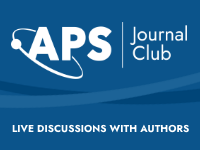| Volume 108, Issues 3 - 4 August 2023 | |
Advertisement | APS has launched two new webinar series. The new Activating Industry Careers series will feature Dr. Peter S. Fisk with "Show Me the Money! Compensation in the Physics Industry" on September 19. The PULSE series for undergraduate students will launch with "Possible Research Areas" on September 27. Register now. | | | | | | Not an APS member? Join today to start connecting with a community of more than 50,000 physicists. | | | | Featured in Physics Editors' Suggestion R. Aaij et al. (LHCb Collaboration) Phys. Rev. D 108, 032002 (2023) – Published 2 August 2023  | New data from observations of B-meson decay again vindicate the standard model of particle physics. | | | | | | Editors' Suggestion R. Aaij et al. (LHCb Collaboration) Phys. Rev. D 108, 034012 (2023) – Published 14 August 2023  | The LHCb collaboration reports the observation of a resonant structure around 3960 MeV that could be a 0++ cc̅ ss̅ state. | | | | | | Editors' Suggestion Pravir Kumar, Ryan M. Shannon, Marcus E. Lower, Adam T. Deller, and J. Xavier Prochaska Phys. Rev. D 108, 043009 (2023) – Published 14 August 2023  | The authors make a polarimetric study of a fast radio burst (FRB) from a particular source. The burst displays a considerable frequency-dependent circularly polarized component, which they analyze within a phenomenological generalized Faraday rotation framework. They find that initially linearly polarized radiation is transformed into circularly polarized radiation by a relativistic plasma located along the line of sight from the progenitor. | | | | | | Editors' Suggestion Adrian E. Bayer, Jia Liu, Ryo Terasawa, Alexandre Barreira, Yici Zhong, and Yu Feng Phys. Rev. D 108, 043521 (2023) – Published 16 August 2023  | The authors study the super-sample covariance (SSC) on higher-order statistics which are becoming standard tools for cosmological inferences from the non-linear small-scale regime of the cosmic structure. To this end, they compare small box sizes of simulations with those embedded in larger simulations that include SCC modes that are cut off by the small boxes. It is observed that these finite-size effects have to be taken into account in future cosmological analyses. | | | | | | Editors' Suggestion L. Filipe O. Costa, José Natário, F. Frutos-Alfaro, and Michael Soffel Phys. Rev. D 108, 044056 (2023) – Published 24 August 2023  | The authors extend the International Astronomical Union (IAU) reference system to a special class of spacetimes that admit non-shearing congruences of observers which, at infinity, have zero vorticity and acceleration. As an application, they analyze several known spacetimes and show that the galaxies' rotation curves cannot be explained through gravitomagnetic effects without the need for dark matter. | | | | | | Editors' Suggestion A. O. Barvinsky and W. Wachowski Phys. Rev. D 108, 045014 (2023) – Published 23 August 2023  | Explicit expressions for anomalies and associated effective actions may take many different forms. Here the authors discuss the conformal anomaly and solve in a clear and explicit manner long-standing confusions and controversies for several wildly different looking effective actions. They show how they are related by different choices of the conformal gauge, reflecting the ambiguity caused by Weyl-invariant pieces. They also discuss applications of these new results to anomaly-driven inflation and the "running" of gravitational and cosmological constants. | | | | | | Editors' Suggestion Letter M. Ablikim et al. (BESIII Collaboration) Phys. Rev. D 108, L031106 (2023) – Published 23 August 2023  | The authors provide the most accurate up to date tests of CP symmetry for neutral hyperons in the decay of J/ψ. | | | | | | | |


No comments:
Post a Comment